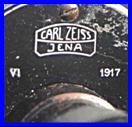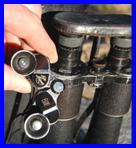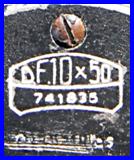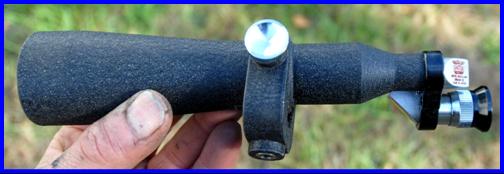
|
Length of Objective Barrels of Binoculars or Telescopes . Länge der Röhre von Fernglas. Longueur du Tube de Jumelles. Длина трубы бинокли. 双眼鏡 の管の長さ Längden på Röret Kikare. Longitud del tubo de Prismáticos. Lunghezza di Barili Obiettivi di Binocoli o Telescopi. |
|
Miniature Binoculars with Sports Organization Endorsement. Miniatur-Ferngläser mit Sport Endorsement. Jumelles Miniatures avec Endossement Sport. Миниатюрные бинокли со спортивным одобрения. スポーツエンドースメント付きミニチュア双眼鏡. Miniatyr Kikare med Sports Endorsement. Prismáticos en Miniatura con Aval Deportes. Binocolo in Miniatura con L’approvazione Dell’organizzazione Sportiva. |
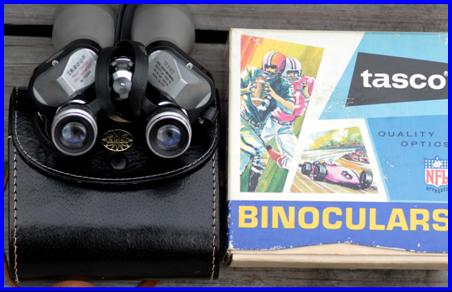
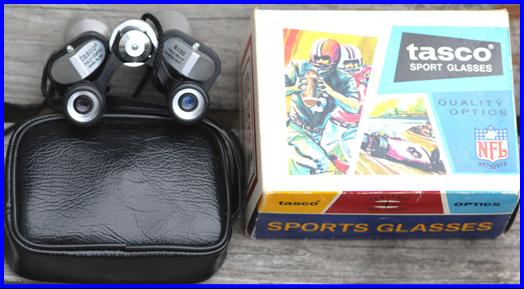
|
Companies distributing and selling consumer products have long known that the obsessive self association of fans with their chosen sports organizations can be exploited quite effectively in selling products. Around 1971 Tasco Sales licensed an NFL (US National Football League) licensing endorsement for their binoculars. The boxes were marked with the NFL logo and “approved” marking. The binoculars themselves were normal models without any special markings, so the consumer sports fans really didn’t get much that was special other than a pasteboard box. In fact the 12 x 40 # 505 ringsider model pictured above left and sold with the NFL endorsement were actually Tasco’s German and European model binoculars that were not really intended for the US market, complete with their German markings. But perhaps the sports fans thought “ VOLL VERGOTET” mean “Go Team” and “WEITWINKEL” was meant “Quarterback Special?’ Actually, it is likely Tasco Sales saw it as a perfect opportunity to sell slow moving stock from one market in another market with that NFL endorsement and if the NFL saw the “VOLL VERGOTET” marking they just assumed the deal was fully coated in profits for them. |
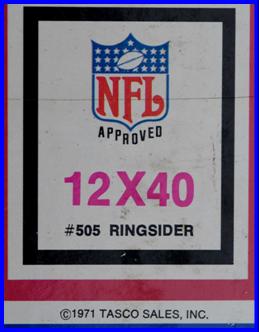

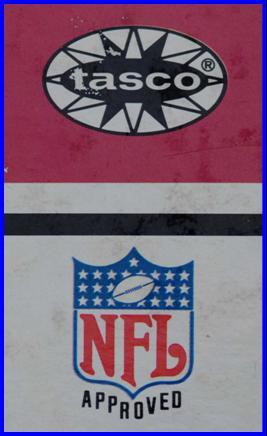
|
Tasco NFL licensed 12x40 binoculars Collection of Mark Ohno |
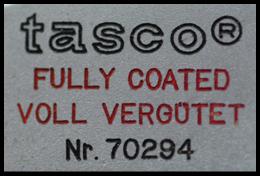
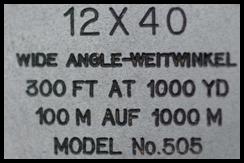

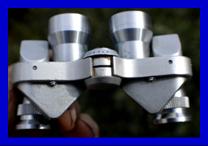
|
Japanese External Reverse Porro Prism Binoculars. VIRTUAL MUSEUM |
|
Even the most casual observer of binoculars will have noticed the wide variation in the overall length of binoculars. The design of binoculars always involves an interaction between prism arrangement and distance between lenses and lens diameter and the resulting magnification and width (angle) of view) and amount of light passed. With design aspects subject to practicality of use. The intuitive assumption is that longer is more powerful. Usually this is so, but not necessarily proportionally. Above left are Japanese WWII ship’s 15x80 binoculars(15x magnification) whose length illustrates the double telescope origins of binoculars and are of a size that is normally mounted and not hand held. Above right are Japanese post war 6x15 (6x magnification) binoculars designed to be small. If all other design factors are the same (they aren’t above) then a simple, inexpensive, and common way to increasing magnification is to increase the objective barrel length to allow an increase in the distance between the prisms and the objective (furthest) lens. The relationship of objective barrel length to magnification can be illustrated by the following examples, which are quite similar in design and in components except for the objective barrel length and objective lens diameter. |
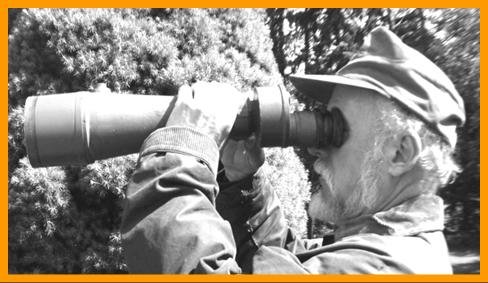
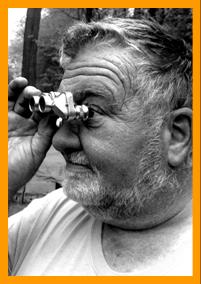
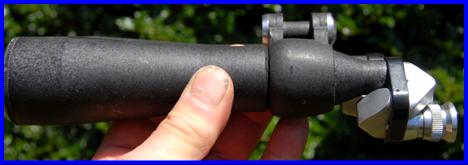
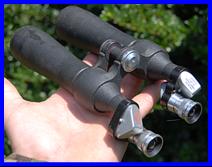
|
The United Falcon 20x40 (20 x magnification) binoculars have an extended objective tube of around 125.7 mm |
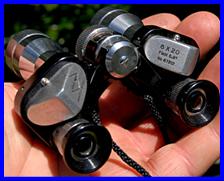
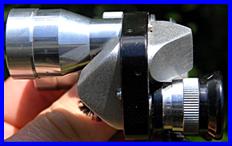
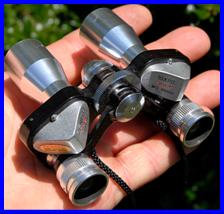
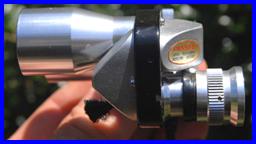
|
By comparison United 10x20 (10x magnification) binoculars have an objective tube length of around 40 mm |
|
Dollands 8x20 (8x magnification) binoculars have an objective tube length of around 38 mm |
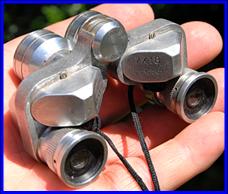
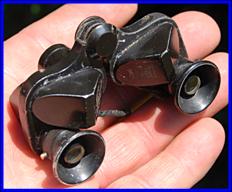
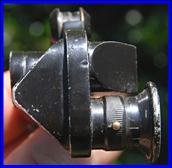

|
United 7x18 (7x magnification) binoculars have an objective tube length of around 25.5 mm |
|
Fata Morgana 4x12 (4x magnification) binoculars have an objective tube length of around 14.4 mm, one of the shorter objective tube lengths |
|
Telescopes, Spotting Scopes, and Monoculars of a Similar Design to the Miniature Binoculars. Teleskope, Spektive und Monokulare Ähnlicher Bauart wie die Miniaturferngläser. Té.lescopes, Longues-vues et Monoculaires d'un Design Similaire à Celui des Jumelles Miniatures. телескопы, прицельные прицелы и монокуляры аналогичного дизайна для миниатюрного бинокля. 望遠鏡、 スポッティングスコープ、ミニチュア双眼鏡と同様の設計の単眼鏡. T eleskop, Spottskalor och Monokulor av liknande Design till Minikikaren. Telescopios y Monoculares de Diseño Similar a los Binoculares en Miniature. Telescopi, Cannocchiali e Monocoli di un Design Simile al Binocolo in Miniature. |
|
The components used in the Japanese reverse external poro prism miniature binoculars were suitable for use in compact spotting scopes, telescopes, and monoculars, and various scopes and monoculars appeared under a variety of brand names in various markets around the world at around the same time as the binoculars. |
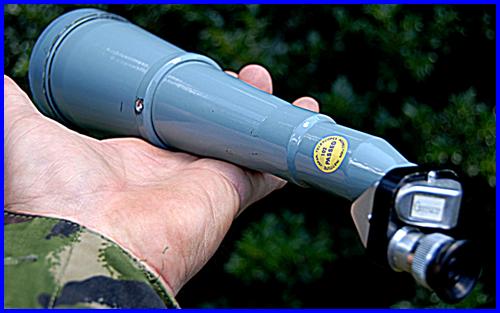
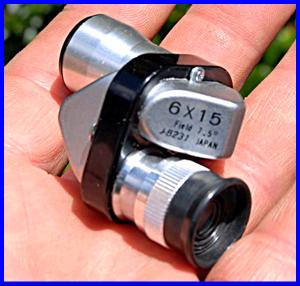
|
Greenkat 30x60 telescope or spotting scope. UK market. (missing tripod yoke). Collection Mark Ohno |
|
38 mm |
|
40 mm |
|
125.7 mm |
|
25.5 mm |
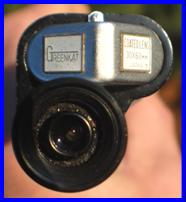

|
Mayflower 6x15 monocular distributed in the USA by Colonial Optical Co of Englewood California, with JB 231 manufacturer code indicating manufacture by Tochihara Optical Co of Japan, a prolific contract manufacturer. |
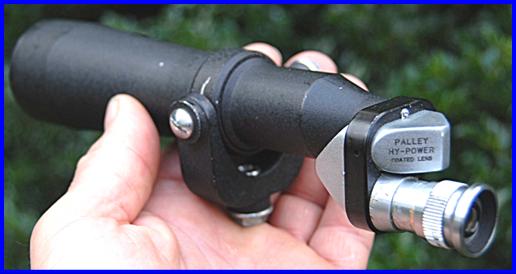
|
Palley 20x40 spotting scope or telescope with yoke (USA market) Collection Mark Ohno |
|
Tasco NFL licensed 8x20 binoculars Collection of Mark Ohno |





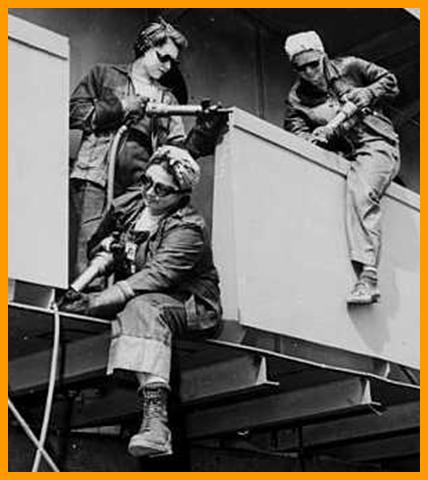
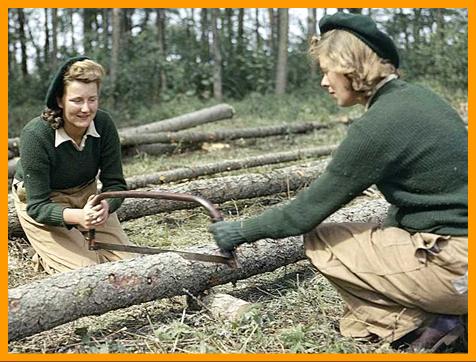




|
14.4 mm |
|
What is the Value of Specific Miniature Binoculars? Was ist der Wert der Spezifischen Minifernglas? Quelle est la Valeur de Miniature Spécifique Jumelles? ミニチュア双眼鏡の特定のペア の値は何ですか? Какова величина удельного Миниатюрные Бинокль? Vad är Värdet av Specifik Miniature Kikare?¿Cuál es el Valor de Específico Prismáticos Miniatura? Qual è il Valore Dei Binocoli Specifici in Miniatura? |
|
I get asked about this. An accurate answer, if not what people want to hear for their purposes, is they are worth what someone is actually willing to pay you for them at a particular point in time, for whatever reason. But I can offer some better insights into how market value functions. Demand and supply are a factor, but actual rarity not so much. I have paid a relative pittance for some of the rarest binoculars because nobody bid against me and that was therefore the value at that moment, because rare but obscure items generate minimal demand, and I have paid more than other miniature binoculars were worth for common ordinary brands of binoculars of little merit, value, or rarity, simply because I was determined to get some specific variant that when someone else happened to want those particular binoculars for whatever reason. Those marketing brands that nobody ever heard of have and that nobody is looking for or wants except me tend to have minimal demand, though they may be technically rare. Miniature binoculars are normally bought by people wishing to use them, or for personal reasons (wanted one as a younger person, friend has one), for novelty value, and probably frequently because someone likes the current production new Nikon Mikron 6x15 or 7x15 binoculars but not the fairly high price of those. I believe that few miniature binoculars are purchased for purposes of collecting. I have only ever heard from, or am aware of, only a handful of making any effort to collect any significant quantity of these. So the plentiful miniature models of really common brands that people have heard people of (Bushnell, Selsi, Binolux, Tasco) may actually more demand than uncommon obscure brands, though because of large number around do not have extra value.
If someone looks on line (“Google search”) to try to find the “value” of miniature binoculars, they will invariably wind up looking at on-line auction sites. So it is worth knowing the secrets of what you are actually seeing when you do that. There is a “market value” in terms of items on online auctions (highest price anyone is actually willing to pay). Miniature binoculars and everything else offered for “buy it now” or with a starting bid below their market value will generally sell and in bidding will generally rise in selling price to their natural “market value”, (if there is any demand at all). So on-line auction items initially priced below market value will sell in the seven days, and then disappear. All the rest of the stuff priced way above market value doesn’t sell, and as a result when you look for miniature binoculars on the on-line auction sites 80% or maybe more of what appears is priced above its value, and will continue to appear in relisted form until the seller gives up or corrects the inflated pricing. I’ve watched a pair of miniature binoculars priced at around four times their worth get relisted for two years and still counting. So looking at on-line auction miniature binoculars “asking prices” that have no bids is not a useful way to get values, because you are looking almost entirely at what people WILL NOT pay for them. In terms of generalities about miniature binoculars values, I have been the HIGH BIDDER in COMPETITIVE BIDDING on probably 700-750 pairs of miniature binoculars with bids of UNDER $30. in the past 5 or 6 years. So I think that this is probably a pretty good real world demonstration that $25-$30 is around the market value of most miniature binoculars. Sure there are a few brands that may get more (Nikon/Nippon Kogaku, sometimes Pentax), or circumstances that increase value (such as being like-new and with original retail box). There are a couple other factors to on-line auction activity. It is seasonal: the number of people bidding is quite different in the in seasons when it is nice outside and daylight is long versus when it is dark early and people are shut in and bored. Demand can reflect a very small determined pool of people wanting an item, who bid up every example on offer very aggressively, until they all possess an example, and then the subsequent selling price of identical subsequently listed items can drop by half. Not withstanding, the most practical way to determine fair market value is to look on an auction site like Ebay for the same binoculars and then use the “watch” function to see if they eventually sell and at what price. The vast majority of people intend to use the binoculars and will probably never bid on any examples not claimed to be fully functional, or that are obviously missing parts, with all the finish worn off, badly corroded, or otherwise beat up (regardless of price). |
|
Keeping Track of Miniature Binoculars? Nachverfolgen von Miniaturferngläsern? Отслеживание миниатюрных биноклей? ミニチュア双眼鏡の追跡? Håller koll på miniatyrkikare? ¿Mantener un registro de binoculares en miniatura? Tenere traccia del binocolo in miniatura? |
|
When a collector has accumulated some large number of whatever item they collect, at some point it becomes hard (and then impossible )to remember exactly which variations you have and don’t have, compounded by the number of ones offered for sale that you look at. This results in purchasing things that turn out to be duplications, which makes you feel foolish. Sometimes you see collectors pouring through paper lists of what they have or need, or looking on tablets or computers. Somebody asked how I keep track? I don’t know any other collectors who do it exactly the same way I do. I just go on line to this website and look at the list of what I have and what I know exists but I don’t have (the six binoculars by brand scroll down pages). I don’t think anything much of doing it this way, but other people think it is strange or funny. |

|
Paws, Jaws, Claws and Miniature Binoculars . Pfoten, Klauen, Krallen und Miniaturferngläser. Pattes, Mâchoires, Griffes et Jumelles Miniatures. Лапы, челюсти, когти и миниатюрные бинокли. 足、顎、爪 およびミニ双眼鏡 . Tassar, Käkar, Klor och Minikikare. Patas, Mandíbulas, Garras y Binoculares en Miniature. Zampe, Mascelle, Artigli e Binocoli in Miniature. |
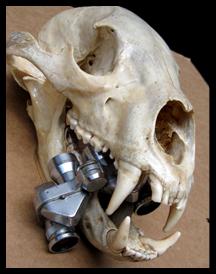
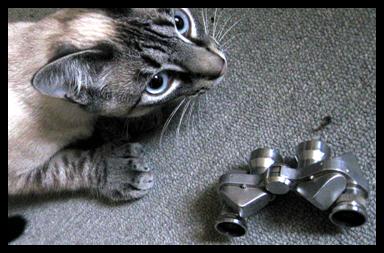
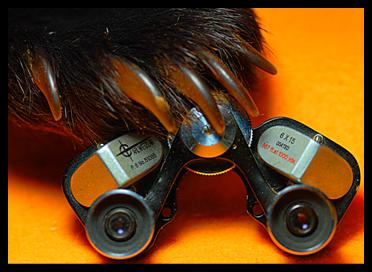
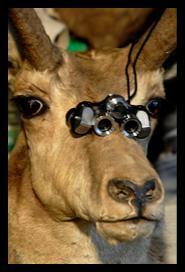
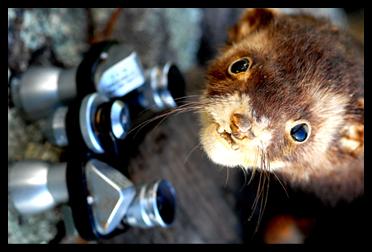
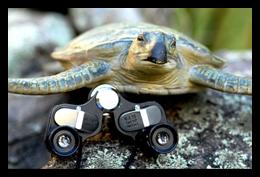
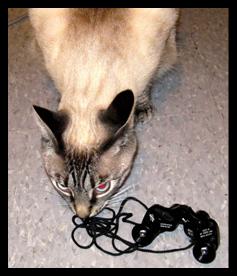
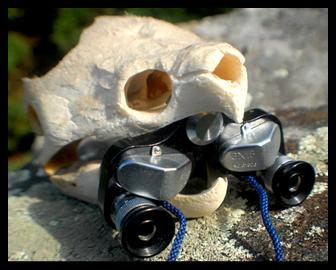
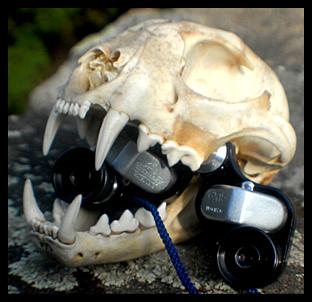
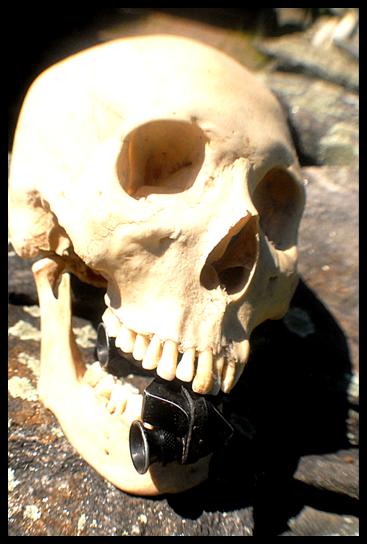
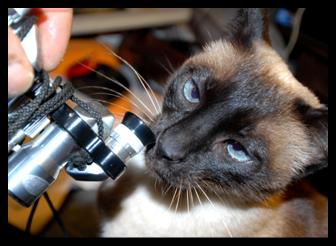

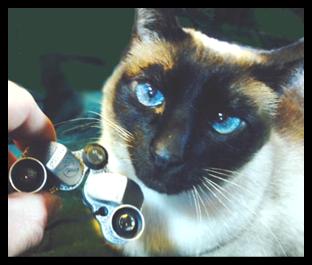
|
In doing research for this website I have come across some other binocular oriented websites that I enjoyed and which I would like to recommend. They generally address vintage larger binoculars and similar optics topics. Listed in no particular order they are as follows. (you will have to copy and paste the web address). MANY BINOCULAR REFERENCE SOURCES (PETER ABRAHAMS), (this is a primary source compendium of binocular research resources). http://www.europa.com/~telscope/binotele.htm VINTAGE MONOCULAR PHOTOS (ULRICH ZEUN):http://www.monocular.info NIPPON KOGAKU MIKRON (NICO WESTPHAL and HANS BRAAKHUIS):http://www.box.com/shared/1ax0zo2dk1 EXTENSIVELY RESEARCHED BINOCULAR HISTORY OF NIPPON KOGAKU & NIKON (HANS BRAAKHUIS): http://www.hansbraakhuis.nl/history%20Nippon%20Kogaku%20Nikon.pdf VINTAGE BINOCULAR PHOTOS (TED BRINK): http://tedbrink.webs.com/usa.htm VINTAGE BINOCULARS WITH HISTORICAL DATA & PHOTOS (ANNA & TERRY VACANI): http://www.binoculars-cinecollectors.com/ VINTAGE BINOCULAR PHOTOS (GARY HAWKINS):http://www.pbase.com/g_hawkins/binocular_pictures&page=all VINTAGE BINOCULAR PHOTOS (SIMON SPIERS):http://flickeflu.com/photos/29616687@N05 VINTAGE BINOCULAR PHOTOS (FRANK FLAGORIO):http://www.flickr.com/photos/binocwpg/sets/72157623234405689/detail/ VINTAGE JAPANESE OPTICAL CO DATA (CAMERAPEDIA ON WIKIA), 5,000+ pages of info, camera specific, but some overlap to binoculars makers: http://www.http://camerapedia.wikia.com OPTICAL FUNGUS (RICHARD J KINCH) http://www.truetex.com/lens_fungus.htm OPTREP UK (commercial binocular repair place, but interesting binoculars shown)http://www.opticalrepairs.com |
|
I RECOMMEND THESE WEB SITES ABOUT BINOCULARS. Andere gute Website auf Ferngläsern. D'autres Bons Sites Web sur des Jumelles. Бинокли веб-сайтов я P екомендую. 私 は双眼鏡については、これらの Web サイトをお勧めします。 JAG Rekommenderar Dessa Webbplatser om Kikare. Recomiendo Estos Sitios Web en Prismáticos. Raccomando Questi Siti di Binocolo. |
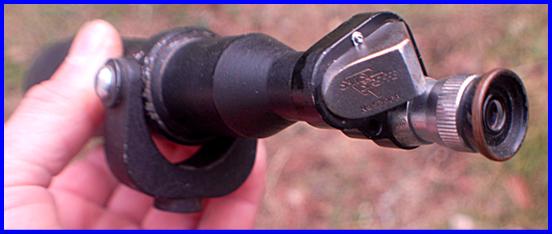
|
Palley 20x40 spotting scope or telescope with yoke (USA market) Collection Mark Ohno |

|
Sans & Streiffe 20x40 spotting scope or telescope with yoke (USA market) Collection Mark Ohno |
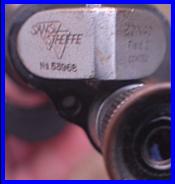
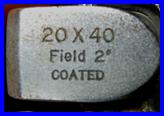
|
German Binoculars, Large and Miniature, 1917-1923. Deutsche Ferngläser, groß und klein, 1917-1923.Jumelles allemandes, grandes et miniatures, 1917-1923. Немецкий бинокль, большой и миниатюрный, 1917-1923 гг. ドイツの双眼鏡、大型と小型、 1917-1923. Tysk kikare, stor och miniatyr, 1917-1923.Prismáticos alemanes, grandes y en miniatura, 1917-1923.Binocolo tedesco, grande e miniatura, 1917-1923. Γερμανικά κιάλια, μεγάλα και μικροσκοπικά, 1917-1923 ناظير ألمانية كبيرة وصغيرة. |
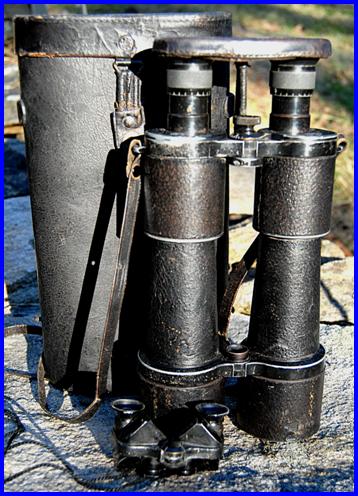

|
Here we have two German prism binoculars made within around 6 years of each other around 100 years ago (the larger was manufactured in 1917 for WWI military use, the smaller was probably manufactured around 1922 or 1923 for the luxury consumer market. Both were quite high end at the time. Of course the smaller pair are Fata Morgana 4x reverse poro prism miniature binoculars patented in 1919, and display how compact poro prism binoculars can be. The larger binoculars are Carl Zeiss 10x50 dienstglas (military service binoculars) and display some of the “twin telescope” outward character of the origin of binoculars, and of magnification through objective barrel length, and utilize an Abbe-Koenig roof prism design. Though both binoculars are around a century old, both probably offer better optics and certainly more character than the average price point binocular offerings at your local discount or sporting goods store. |
